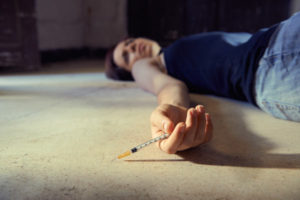Heroin is one of the most popular illegal substances across the United States and the world. It works by impacting the brain’s reward system and over time, increases the user’s tolerance levels. As time goes on, the person will consistently increase doses each time they take the drug. The vicious cycle of heroin abuse starts with taking drugs and progresses to the point of taking it, so it suppresses the withdrawal symptoms. Withdrawal from heroin is far worse than that of prescribed painkillers.
Heroin falls into the category of opiates. It produces feel-good chemicals in the brain, such as dopamine and endorphins; hence, it’s highly addictive properties. Strong addiction occurs after the brain begins associating the activation of these chemicals, and furthermore cannot operate properly without the drug. Adding to this is intense withdrawal symptoms that come with using heroin consistently. Heroin can come in its purest form, such as fine white powder, brown or black powder, or even black tar heroin, which comes in a dark sticky gel. Each of them has different levels of intensity and problems that affect health. The reason people use this drug is that it produces an intense feeling of happiness. People have attributed this feeling as a sort of rush that reaches the brain at hyper speed.
The effects of injecting heroin into the bloodstream can occur in approximately two minutes. The pleasure is similar to an orgasm, and the high lasts for about four to five hours at most. During this high, the person may experience reduced anxiety, tension relief, and a general feeling of overall well-being. It’s hard to steer away from heroin due to the fact that the person may feel it’s the only way for them to feel happy, relaxed, or simply well off. The effects are quite enjoyable and don’t come with any hangovers or comedowns.
As the addiction intensifies and time goes on, things begin to become more dangerous, and the fear of overdosing is a threatening reality.
Heroin Withdrawal Symptoms
A few hours after taking the last dose of heroin, the person may begin to experience withdrawal symptoms, usually after the five hours that the high tends to last. The person begins to experience flu-like symptoms.
Some symptoms include:
- Anxiety
- Diarrhea
- Sweating
- Agitation
- Muscle pain
Heroin Withdrawal Timeline Factors
When talking about a specific timeline in the withdrawal phase, there are certain things to keep in mind. Some of these factors include the length of time the user had been taking heroin, frequency, any prior mental health issues, and the number of doses the user took during that time.
Length of Time
People who have been struggling with heroin abuse for months or years are usually the ones who have a harder time with the withdrawal timeline. While some people may face a few weeks to months of withdrawal symptoms, hardcore addicted people will feel like these symptoms were meant to stay forever. For this reason, anyone who feels they are getting hooked on heroin or any other substance should seek medical treatment before it’s too late.
Frequency
The frequency with which the user takes the drug is usually dependent on the drug’s effects themselves. As mentioned above, the drug’s effects usually last around five to six hours. A realistic scenario is 3 to 4 doses in a day if the person is highly addicted.
Mental Health
Mental health also plays a big part in the withdrawal timeline and its intensity. Coping with a strong mental disability can only worsen during the withdrawal phase from heroin. The combination of a pleasant high with mental imbalances can lead the person to feel out of control when the drug is no longer administered. A person’s psychological reactions mixed with heroin’s psychological effects are a common but deadly combination. For this reason, a person who aims to quit must also receive psychological therapy.
Doses
Higher doses over time will result in greater tolerance to the drug. This results in people having stronger setbacks when they quit cold turkey. The brain can only endure so much heroin until it doesn’t anymore, causing the crash to be very intense for the person’s sanity and physical well-being.
Keeping all these things in mind, we can now set a timeline.
First Hours
After the initial five hours of heroin intake, the symptoms will start to creep in slowly. The body, which is used to constantly absorbing heroin, will start to wonder why no more stimulant has been taken. The person will begin to feel muscle pains, have insomnia, feel anxious, and get diarrhea.
First Week
The first few days are very harsh for the body. Symptoms have increased causing, greater abdominal cramps, sweating, and vomiting. Many times during this period, people may find themselves relapsing or taking other substances to cancel out the adverse withdrawal symptoms.
First Month
After two weeks, the acute withdrawal phase has ended. It’s safe to say that during this time, former users will feel more comfortable. The cause for concern is not present anymore. The first month or so, certain neurological changes caused by heroin will manifest. The common long-lasting symptoms are sadness, depression, insomnia, and fatigue.
Why Should I Detox?

Detoxification is the first stage in the recovery from heroin abuse. Without this first crucial step, a person is never fully recovered. For this reason alone, many times, people can’t seem to eradicate their addiction problems forever. Medical detox carried out by a professional staff of doctors and nurses administer medication and supervise therapy that will allow patients to solve their troubles and face their addictions. It is a lack of medical detox that plagues the lives of many people struggling with addiction across the country. Detox helps prevent dehydration, stops the addiction process, eases out the withdrawal phase and much more.
Someone struggling with heroin addiction may think it’s easier to detox from the drug at home. However, they are quite vulnerable to overdosing as their sensitivity goes up, and their tolerance goes down. For these reasons, detoxing at an accredited addiction treatment center is strongly advised.
What is the Next Treatment Step?
The next step is participating in a program that will advance the recovery process. Each case is different, which is why not all programs will be effective for the client. For more severe addiction problems, residential treatment programs are recommended. People will receive supervision, treatment, and therapy 24/7 while residing in the institute’s facilities. For those who are not going through serious addiction problems, they can opt to participate in outpatient treatment programs. These treatment programs usually consist of checking in and out in an established period of time by the doctor.
“Heroin.” MedlinePlus, U.S. National Library of Medicine. Retrieved from: medlineplus.gov/heroin.html
National Institute on Drug Abuse. “Heroin.” NIDA. Retrieved from: www.drugabuse.gov/publications/drugfacts/heroin
“Opiate and Opioid Withdrawal: MedlinePlus Medical Encyclopedia.” MedlinePlus, U.S. National Library of Medicine. Retrieved from: medlineplus.gov/ency/article/000949.htm


